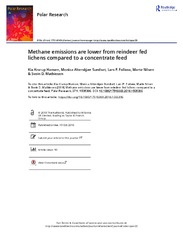Methane emissions are lower from reindeer fed lichens compared to a concentrate feed
Permanent lenke
https://hdl.handle.net/10037/14158Dato
2018Type
Journal articleTidsskriftartikkel
Peer reviewed
Forfatter
Hansen, Kia Krarup; Sundset, Monica Alterskjær; Folkow, Lars; Nilsen, Marte; Mathiesen, Svein DischSammendrag
Methane emissions from reindeer (Rangifer tarandus tarandus) fed lichens (mainly Cladonia
stellaris) and a concentrate feed were determined using open-circuit respirometry. The lichen
diet was low in crude protein (< 2.6% of dry matter [DM]), starch (6.0% DM) and acid
detergent lignin (2.0% DM) compared to the concentrate feed (12.7, 22.5 and 7.2% DM,
respectively), and high in neutral detergent fibre (82.2% DM versus 34.8% DM in concentrate
feed). The feeds were offered in equal amounts (ca. 0.440 kg DM) 2 h after initiating methane
recordings in the respiration chamber. The reindeer were adapted to these diets for
> 4 weeks prior to experiments and methane emissions recorded for two separate 23 h
periods for each diet. Methane emissions increased on average by 0.93 g/h (or by 5.8 times) in
the first hour after feeding the concentrate feed, while emissions remained unchanged after
the intake of lichens. Mean methane emissions from reindeer (n = 5) were 7.5 ± 0.54 (SE) g
CH4 day−1 when fed lichens, compared to a higher emission (p = 0.001) of 11.2 ± 0.54 g CH4
day−1 on the concentrate diet. The mean proportion of gross energy intake lost as methane
was 5.2 ± 0.37% on the lichens and 7.6 ± 0.37%, or some 50% higher, on the concentrate
feed. This difference was significant (p < 0.001). Our results suggest that it is of environmental
importance to preserve the lichens on the tundra and minimize supplementary feeding with
concentrate diets, in order to reduce methane emission.


 English
English norsk
norsk